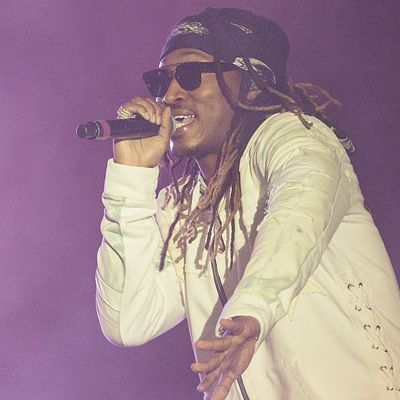
It’s been a quiet few months for Future since the beginning of the year: Following the January release of his mixtape Purple Reign and the February release of his album EVOL, the Atlanta rapper and Auto-Tune maestro has been largely silent, confining his public activity to nightclub appearances and touring — and, as the curfew-related cancellation of Future’s appearance at Summer Jam this past weekend shows, even his concerts can be muted. Still, given Future’s truly colossal output during 2015, when he released three solo mixtapes, a solo album, and a mixtape in collaboration with Drake, it’s impossible to begrudge the artist a respite from nonstop production. Once his body of work took on a life of its own, there’s been less need for him to personally exert himself.
The RIAA’s announcement today that Future’s 2015 album Dirty Sprite 2 has achieved platinum status is a perfect illustration of how much Future can afford to bask in the light of his prior achievements: Released almost a year ago in July, DS2 marks the first solo platinum album for the artist. However overdue, the status is richly deserved. Alternating between soul-pounding calls to arms (“I Serve the Base,” “Groupies,” “Stick Talk”) and mournful contemplations (“Rich Sex,” “Blood on the Money,” “Kno the Meaning”) while remaining consistently dark, fluent, and prideful in tone, DS2 is Future’s apex collection, the culmination of his entire career preceding it.
Yet Future’s career following his triumphal album demonstrates one of the dominant narratives in his songs preceding it: the progression from focused high to confused hangover. Since DS2, the artist has essentially been treading (carbonated, codeine-infused) water, though not without profit: After emerging as the hottest rap artist of 2015, his concert fees and club-walk-through prices have been enormous. To a certain degree, platinum status has become superfluous in an era when the revenue from a few appearances at nightclubs in Dubai and Los Angeles can match the royalties from hundreds of thousands of albums sold. As the record industry wanes, the honors it bestows lose brilliance.
As for what Future’s future holds, it’s unclear. There’s certainly evidence on Purple Reign and EVOL that points to him recycling himself to diminishing returns, but here’s hoping that his trajectory follows that of the Weeknd, his collaborator on EVOL’s sole hit song, “Low Life.” Like Future, the Toronto singer Abęl Tesfaye achieved legendary underground status with a series of album-quality mixtapes on which, blending a keen sense of R&B melody with a harsher sensibility absorbed from rap, each artist glamorized drug-induced excess as well its debased aftermath. Like Future, the Weeknd’s infamy reached the point where Drake approached him to borrow his voice and gently ransack his hoard of instrumentals: What a Time to Be Alive is a collaboration between Drake and Future in much the same way Take Care belongs as much to Drake as to the Weeknd, upon whose credited and uncredited songwriting that album’s best moments depend. Gaining popular visibility but losing artistic momentum from their association with Drake, both artists entered a period of relative stagnation: What Kiss Land was to the Weeknd, EVOL is to Future. Given all these parallels, and given that Tesfaye’s music since Kiss Land has been impeccably glorious, it’s possible that Future will recover from his Drake-jacking, turn over a new leaf, and return to excellence — possible, and very much worth hoping for.

